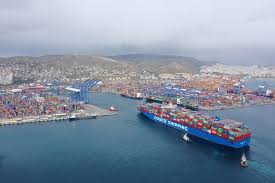By Shang Kaiyuan, People’s Daily
At the recently third United Nations Ocean Conference (UNOC3) in Nice, France, China and the European Union (EU) held substantive discussions on marine conservation, port decarbonization, and digital ocean development. These interactions exactly highlighted the vitality of the China-EU Blue Partnership within multilateral frameworks.
Through proactive collaboration on maritime issues, this partnership advances global ocean governance, strengthens the China-EU comprehensive strategic partnership, and injects fresh momentum into robust bilateral relations.
Established in July 2018 as the EU’s first such agreement with a non-member state, the China-EU Blue Partnership promotes sustainable ocean governance, fisheries management, and maritime economic growth. It marked the EU’s first blue partnership with a non-EU country.
Since its inception, both parties have collaborated on critical global ocean agendas – including climate action, marine biodiversity protection, plastic pollution reduction, and the UN Decade of Ocean Science for Sustainable Development. Both sides advocate for multilateral cooperation to seek sustainable solutions to shared ocean-related challenges.
Building on this foundation, China and France – as key partners – have further solidified cooperation in these domains.
In 2018, the two countries jointly launched the China-France Oceanography Satellite (CFOSAT) – their first joint ocean-observing satellite. Under the partnership, China provided the satellite platform, wind observation instruments, launch services, and mission control, while France supplied the wave measurement payload.
The satellite’s shared data enhances maritime safety, disaster risk reduction, and ocean resource surveying. The satellite’s service life has been extended twice, and it continues to provide valuable data for global ocean monitoring.
“In the past, satellites could measure either wind or waves, but not both simultaneously. CFOSAT overcame that limitation. It’s a great example of successful scientific collaboration,” said Qiao Fangli, deputy director of the First Institute of Oceanography under China’s Ministry of Natural Resources.
China and the EU enjoy complementary strengths and mutual benefits in trade and economic cooperation, forming a deeply interdependent economic relationship. Ports, shipping, and logistics are key pillars of this economic partnership, and promoting green, lower-carbon trade is a key focus of China-EU blue economy collaboration.
On the northeastern coast of the Mediterranean, the Piraeus port in Greece serves as a vital hub for China-EU maritime connectivity. Since China’s COSCO Shipping took over its operation, the port has experienced rapid growth, becoming a flagship project under the Belt and Road Initiative. The port’s upgrade has not only improved regional logistics efficiency but also accelerated the green and intelligent transformation of southern European ports.
In 2023, China’s Shandong Port Group officially began operations in the Port of Rotterdam, the Netherlands. The group has built substantial experience in low-carbon and smart port development, pioneering several “firsts” in China and globally – such as China’s first automatic battery-swap station for container trucks, the first hydrogen refueling station at a port, and the world’s first smart terminal enabled by hydrogen energy and 5G. These innovations provide a strong foundation for deeper cooperation with European ports.
“Green transformation, digital empowerment, and enhanced international coordination define shipping’s future,” said Cao Peng, general manager of the Overseas Development Group of Shandong Port Group. “European partnerships will actively advance these priorities.”
For both China and the EU, the ocean is more than a critical resource and development space. It is also a vital arena for practicing multilateralism and participating in global governance.
Both China and the EU are staunch advocates of multilateralism and actively contribute to shaping international maritime rules. In addressing challenges such as marine pollution and ecological degradation, China and the EU continue to explore scalable governance solutions.
Zhejiang province in east China introduced a “blue circular economy” model for plastic pollution control, integrating plastic reduction at the source, joint land-sea prevention, and recycling. The model earned the UN’s Champions of the Earth Award. Meanwhile, the French NGO “Plastic Odyssey” promotes locally viable solutions to plastic pollution, implementing small-scale recycling projects in some of the world’s most affected coastal areas.
In sustainable fisheries development, China and the EU have each developed unique best practices. China’s Fuxi No.1 wind power-fishery integrated platform combines renewable energy development with ecosystem restoration, creating a joint model of “power generation, aquaculture, and ecological rehabilitation.” A French company has installed artificial reef structures near coastlines to serve as shelters for juvenile fish.
As Benjamin Denjean, a researcher at France’s Green Ocean Institut, put it: “China and the EU share a deep concern for the ocean, offer complementary ideas, and benefit from mutual learning.” That complementarity is now flowering into renewed vitality as the China-EU Blue Partnership continues to grow and deepen.
